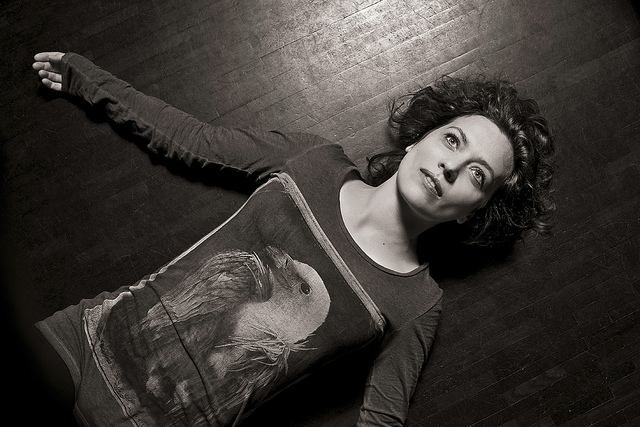Last spring, as pale pink cherry blossoms were being knocked from the trees by the Portland rain, I lay in final shavasna while my teacher Sheila guided the class through a meditation on dying.
After several years of practicing yoga I knew, of course, that shavasna means corpse pose, and I had probably heard the meditation before, but this time it resonated deeply. On that day–death closer to me than I had ever known it to be—her words were exceptionally powerful.
My father had been diagnosed with pancreatic cancer several years earlier and had already outlived the typical prognosis for this type of cancer. And although the tumor rooted in his pancreas seemed to be responding well to the onslaught of chemotherapy and radiation, there was something about the tenuous relationship he had developed with this world that made me think he was nearing the next. His skin was yellowed and he spent his days in a netherworld of naps on the couch.
Lying upon my mat on the maple floors of the familiar neighborhood studio, I thought of my father as Sheila prompted us to imagine our very last exhale.
The idea of the body’s last breath, the last time you breathe air out, and then never again breathe back in, initially made me panicky; I thought of drowning or being smothered. Instead of slowing, my breath quickened and my heart galloped. I wanted to sit up.
But in this studio I had been learning how to breathe through difficult situations—how to breathe when my body was telling me to collapse—and instead of sitting up I filled my lungs. I pictured breath entering and leaving my body, and then I imagined it leaving, never to come back. I imagined this for myself, but also for my father. I thought about how before very long he would breathe out and not breathe in again. About how his weighty body would be left behind like a log to the forest floor.
I exhaled all of the air from my body—all that I could possibly squeeze out—and briefly I could imagine it not flowing back in, could imagine stepping out of my earthbound being.
For an instant I felt as close to imagining the unimaginable for both myself and for my father as I could.
It was several months later, over a giddy fourth of July weekend spent camping in the San Juan Islands, that my sister called to tell me that our father was in the hospital. He had developed an infection and was unconscious. As I waited with my husband and three children to catch the ferry back to the mainland, then inched south on Interstate Five, I felt my dad getting further from me—that he was receding faster than I could possibly reach him.
It was almost evening when we finally made it to the hospital in Portland. I was led back to the ICU, where I found my father in a perfect imitation of shavasana. He was lying on his back, his arms at his sides with his palms up, his feet were splayed sideways. He was riddled with the paraphernalia of modern medicine; tubes and monitors snaked into a livid red hematoma on his bloated neck; a thick, ribbed plastic tube was taped into his mouth. His chest rose and fell perfectly regularly, but I realized that a machine was doing the breathing for him.
I started practicing yoga the minute I walked into that hectic, blinking room. It was not a conscious choice.
My body began to breathe for me, as if aware that the simple act of deliberate breath could steady me. Air came streaming in through my nostrils, swelled my lungs against the constriction of shock and then inflated my stomach despite how it wanted to knot. And then a tiny pause before all that air came slowly out.
I kept breathing when the nurse came in and we slowly realized she was telling us that without all these machines and drugs my father would die; I kept breathing while I held his swollen, cooling hand and hoped that somehow he could sense that I was there; I kept breathing while infection ran rampant and invisible through his organs, shutting them down one after the other.
Inhaling and then exhaling had become my only measure of time when the doctor came into the room and told us he recommended ceasing the medications coursing into my father’s body and removing the breathing tube. He explained that my father would die rapidly after this happened.
I kept breathing while I watched my father’s wife of 35 years struggle on the sharp hook of such a decision. When she did accept the doctor’s judgment—when we had come to believe that being kept alive was not what my father would have wanted—we were given a final reprieve with him; it was shift change and some critical piece of information that was needed to start the process of death was stalled in a computer in another room.
And still I was breathing as I waited for my father to be untethered.
I was holding his hand while my mind constricted to only my breath. A long slow inhale, a long steady exhale. Maybe it was as close to meditating as I have ever come: my consciousness narrowed to only my breath and the figure beside me beneath the hospital blanket.
When it happened, it happened quickly. My father was being fed several different powerful drugs and as they were clicked off the beeps began to slow, the digital mountains began to flatten; I watched this, and I continued to breathe. And as I did, I was recalled to that spring morning months before in the studio. I remembered imagining this: the very last breaths before death. I remembered passing through a wave of panic.
Each one of my inhales became slower; I exhaled long and deliberate.
My father’s chest was still rising and falling jerkily with the breathing tube, but a nurse hurried to unhook it.
It was coming so quickly: the last time my father’s lungs would fill with air, the last time they would be released. I was breathing with him.
The nurse extracted the tube from his mouth. Without it, my father took one last heaving drink of air and I accompanied him.
And then it left his body. I watched it. Watched his chest, still broad even after the ravages of chemotherapy, fall. Watched it fall and stay fallen, not rise again the way it had done ever since the moment he was pushed from his mother’s body 70 years before.
I breathed out with him. Held it. One, two, three—for a moment we were both not breathing. And then I breathed back in, filled my lungs, sucked air into my stomach.
I had gone as far as I could go with him: I would stay here and keep breathing, he would continue on without this body.
I have no idea whether my father had thought about his death in the months leading up to it. He never talked to me about it. He was a stoic man and had been taught—like the generation of men he was born into—to bare pain silently, to fight and keep on fighting.
I have no idea if he had considered his final breath; I do not know if his soul was long gone by the time his body was taken off life support. I don’t know if somehow he sensed me breathing in tandem with him during that grinding night in the hospital, and I don’t know if any part of him was aware that his very last breath had a companion as it left his body behind.
All I do know is that the longer I practice yoga the less I know, the less I know I have, and that this is a relief, a release, a blessing. All I know for sure that I have is my breath, and that I will have it until that moment sometime in my future when I breathe it all out and it never returns.
Relephant Read:
How Breathing Correctly Can Change Our Lives.
Author: Kathryn Lipari
Editor: Catherine Monkman
Photo: Myriam Gourfink/Flickr
Facebook is in talks with major corporate media about pulling their content into FB, leaving other sites to wither or pay up if we want to connect with you, our readers. Want to stay connected before the curtain drops? Sign up for our curated, quality newsletters below.

 Share on bsky
Share on bsky







Read 8 comments and reply